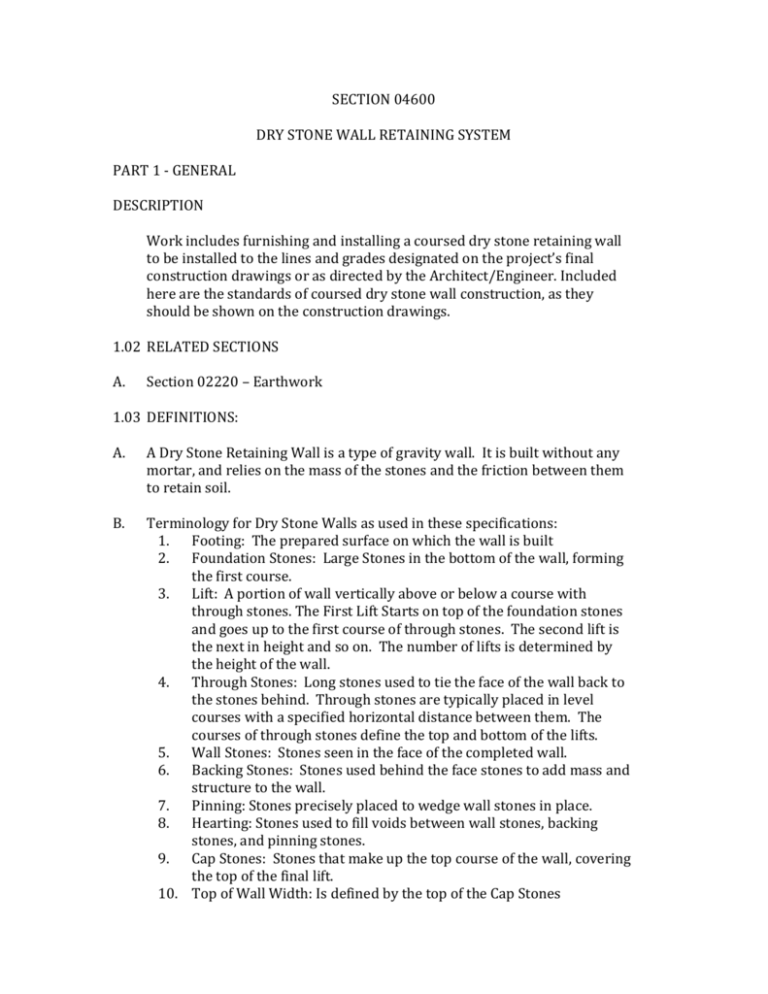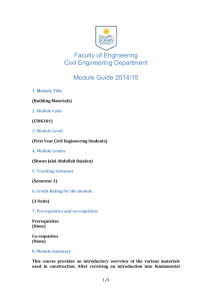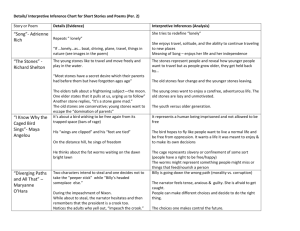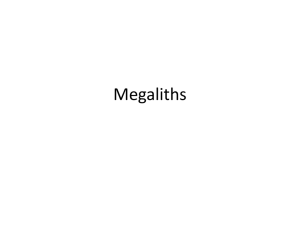SECTION 04600 DRY STONE WALL RETAINING SYSTEM PART 1
advertisement

SECTION 04600 DRY STONE WALL RETAINING SYSTEM PART 1 - GENERAL DESCRIPTION Work includes furnishing and installing a coursed dry stone retaining wall to be installed to the lines and grades designated on the project’s final construction drawings or as directed by the Architect/Engineer. Included here are the standards of coursed dry stone wall construction, as they should be shown on the construction drawings. 1.02 RELATED SECTIONS A. Section 02220 – Earthwork 1.03 DEFINITIONS: A. A Dry Stone Retaining Wall is a type of gravity wall. It is built without any mortar, and relies on the mass of the stones and the friction between them to retain soil. B. Terminology for Dry Stone Walls as used in these specifications: 1. Footing: The prepared surface on which the wall is built 2. Foundation Stones: Large Stones in the bottom of the wall, forming the first course. 3. Lift: A portion of wall vertically above or below a course with through stones. The First Lift Starts on top of the foundation stones and goes up to the first course of through stones. The second lift is the next in height and so on. The number of lifts is determined by the height of the wall. 4. Through Stones: Long stones used to tie the face of the wall back to the stones behind. Through stones are typically placed in level courses with a specified horizontal distance between them. The courses of through stones define the top and bottom of the lifts. 5. Wall Stones: Stones seen in the face of the completed wall. 6. Backing Stones: Stones used behind the face stones to add mass and structure to the wall. 7. Pinning: Stones precisely placed to wedge wall stones in place. 8. Hearting: Stones used to fill voids between wall stones, backing stones, and pinning stones. 9. Cap Stones: Stones that make up the top course of the wall, covering the top of the final lift. 10. Top of Wall Width: Is defined by the top of the Cap Stones 11. Batter: Angle that the face of wall leans back. Typically described in a ratio of ‘distance back’ to ‘height’ such as 1:6. Fig. 1: Cross Section of Typical Dry Stone Retaining Wall with Terminology Fig. 2: Cross Section of Dry Stone Retaining Wall with Terminology 1.04 LAYOUT A. Wall section dimensions are to be determined as follows: 2 * Height * Slope of Batter + Top of Wall Width = Width of Base B. The batter of the exterior face of the wall should be as shown on the construction drawings. The typical range for batter is 1:12 to 1:6. A vertical wall face is not acceptable. 1.05 CONTRACTOR REQUIREMENTS A. The General Contractor shall use certified wall builders (Wallers) to place the Wall Stones in each lift. The entire structure must be built under the supervision and in the presence of the certified Waller(s). Certifications are acceptable from the following organizations: The Dry Stone Walling Association (DSWA), Great Britain Levels II, III, IV The Dry Stone Conservancy (DSC), Kentucky, USA Levels II, III 1.06 SUBMITTTALS A. Certification: Waller certification documentation shall be submitted as part of the bid process. B. Design: All calculations and drawings shall be prepared and sealed by a professional Civil Engineer (PE), Landscape Architect (PLA), or Architect (RA) who is experienced in dry stone wall construction design and licensed in the state where the wall is to be built. Wall Design must consider all information presented in wall elevation, layout, grading, and landscaping plans including but not limited to back slopes, surcharge loads, soil elevations, fence post locations, tree or shrub planting beds, plant growth, and the inclusion of the storm water drainage piping designed by a qualified professional, which will be located within the retained fill for some walls. The wall design professional shall contact the Landscape Architect to coordinate the plant bed design within retained fill when applicable. Work Documentation: Contractor/certified waller shall submit detailed photographic or video documentation of the project from start to completion. This report is to verify correct building techniques. Document to include the following points: C. 1. 2. 3. 4. 5. Site before any work has begun Prepared sub grade Foundation Stone Placement Completed First Lift Through Stones Placement 6. 7. Completed Second Lift Completed Structure D: Material Submittals: The contractor shall submit samples of stone to be used that will be long lasting, of suitable size and shape for the dimensions and style of wall. Examples are to be submitted a minimum of two weeks prior to start of construction. The material must be suitable meet BOTH the Wall Design Engineering specifications and the requirements of PART 2 of these specifications 1.07 DELIVERY, STORAGE, AND HANDLING A. Contractor shall check materials upon delivery to assure that specified type and grade of materials have been received. B. Contractor shall prevent excessive ice, mud, soil, clay, and like materials that may adhere, from coming into contact with the stones. Such materials, if present on the stones, must be removed prior to building. PART 2 - MATERIALS 2.01 SELECTION OF STONE A. The building stone selected must provide adequate stones for all parts of the wall. Different types of stone, and/or stones from different sources may be used to achieve the necessary selection (provided all are approved). B. The following types of stones should be evident in appropriate quantities. 1. Foundation Stones (largest stones) 2. Through Stones (must have appropriate length and shape) 3. Cap Stones (must have appropriate dimensions) 4. Wall Stone and Backing Stones (may be further sorted by size) 5. Pinning and Hearting (small stones and stone chips) 2.02 FOOTING MATERIAL A. Drainage aggregate shall be clean angular stone, allowing water to freely pass through. B. Material must be stable and firm when compacted. C. Commonly available crushed stone aggregate in the size range of ¾” to 1 ½” is typically suitable, unless other specified by wall designer. D. In areas were the ground freezes water must easily pass through the footing material and have a place to drain to well away from the wall. E. In areas were the ground freezes water must easily pass through the footing material and have a place to drain to well away from the wall. 2.03 FOUNDATION STONE MATERIAL A. The foundation stones, as when placed in the wall, shall be at least 1/2 the width of the foundation. As per the grading of material, stones shall be the largest in the selection of building material. B. Stones are to be grouped by height, as when placed in the wall. 2.04 WALL STONES/FIRST LIFT MATERIAL A. A slight reduction in size from the foundation stones, ie: the next largest stones (excluding through stones, caps, or copes). B. Stones should be grouped by height, as when placed in the wall, so that in installation they will comprise horizontal courses. 2.05 PINNING AND HEARTING MATERIAL A. Stones of the size to fill gaps and voids between wall stones, backing stones and other elements of the wall. B. Stones should be the largest size that is possible to use to fill the gaps and voids C. Material that can be shoveled by hand is too small for pinning and hearting. 2.06 THROUGH STONES A. The length of these stones is determined by the width of the wall where they will be placed. The length of the stone must be equal to or greater than the width of the wall where it will be. B. Stones should be of a shape that will be possible to be structurally built upon, as when placed in the wall. 2.07 WALL STONES/ 2ND AND ADDITIONAL LIFTS A. A continued reduction in size of stones with each lift. B. Stones should be grouped by height, as when placed in the wall, so that in installation they will comprise horizontal courses. 2.08 CAP STONES A. These stones must be the full width of the wall at the top of the final lift. B. Cap stones must individually be significant in size and weight such that they are difficult to dislodge or move from placement. C. Stones must be of appropriate size and shape for the type or cap called for in the design. 2.09 BACK STONE MATERIAL A. Back stones shall be of appropriate size and shape to complete the thickness (depth) of each course of the wall. B. Back stones, of similar size to Foundation Stones, and all sizes of wall stones used will be needed. C. Material should be of similar hardness of the Wall Stone. 2.10 BACKFILL AGGREGATE A. Drainage aggregate shall be clean angular stone, that allows water to freely pass through. B. Material must be stable and firm when compacted. C. Aggregate size must be large enough that water will not “wash” it through the wall. D. Commonly available crushed stone aggregate in the size range of ¾” to 1 ½” is typically suitable, unless other specified by wall designer. PART 3 – CONSTRUCTION 3.01 EXCAVATION A. Contractor shall excavate to the lines and grades shown on the project grading plans. Contractor shall take precautions to minimize overexcavation. Over-excavation shall be filled with compacted infill material, or as directed by the Engineer/Architect, at the Contractor's expense. B. Contractor shall verify location of existing structures and utilities prior to excavation. Contractor shall ensure all surrounding structures are protected from the effects of wall excavation. Excavation support, if required, is the responsibility of the Contractor. 3.02 FOOTING A. Following the excavation, the subgrade soil shall be examined by the Owner's Engineer to assure actual foundation soil strength meets or exceeds the assumed design bearing strength. Soils not meeting the required strength shall be removed and replaced with infill soils, as directed by the Owner's Engineer. B. The subgrade soil shall be proof rolled and compacted to 95% standard Proctor density and inspected by the Owner's Engineer prior to placement of footing material. C. The footing material shall be placed to the depth and width called for in the construction documents. It shall be proof rolled and compacted to 95% standard Proctor density and inspected by the Owner's Engineer prior to placement of Foundation Stones. D. If called for, drainage pipe and geosynthetic filter fabric shall be placed as required in the construction drawings. 3.03 SORTING BUILDING STONE MATERIAL A. The selected building stone should be sorted through. Similarly sized stones should be grouped together with attention to creating a safe and efficient work site. The following groups should be visible to the trained eye: 1. Foundation Stones (largest stones) 2. Through Stones (must have appropriate length and shape) 3. Cap or Cope Stones (must have appropriate dimensions) 4. Wall Stone and Backing Stones (may be further sorted by size) 5. Pinning and Hearting (small stones and stone chips) 3.04 PREPARING TO BUILD A. The Contractor shall build the wall in the location shown on the project plans. B. The Contractor shall build the wall to the dimensions and grades shown on the project plans. C. The exterior face of the wall shall have no bulges or hollows D. String lines or other guides should be used to achieve a straight, even wall face and level courses. 3.05 BUILDING THE WALL A. B. FOUNDATION STONES 1. All stones shall be placed with their length into the wall structure (perpendicular to the face of the wall). 2. Stones should be placed with so the joints near the face of the wall are tight. The wall stones should be in contact with the wall stones on either side. 3. Stones should be set level. 4. To the greatest extent possible, stones of the same height should be placed next to each other to form an even horizontal course. 5. The underside of the stone shall be free of voids and well packed with footing material 6. Stones shall be set so that the top edge of the face (portion of stone visible in completed wall) is in line with the plane of the wall. 7. Back stones of equivalent height and size to the foundation stones shall be placed behind the foundation stones. The length of each back stone shall be placed perpendicular to the face of the wall. 8. Pinning and hearting shall be carefully placed by hand to fill all voids and gaps between all foundation stones and back stones. Fewer larger pieces should be used rather than many small pieces. WALL STONES – FIRST LIFT 1. All stones shall be placed with their length into the wall structure (perpendicular to the face of the wall). 2. Stones must span the vertical joints between stones in the course below. Each stone spanning a joint must have at least 1/3 of its width to either side of the joint, and must have contact with and bear weight on both wall stones below. 3. Wall stones should not be placed to sit on more than two wall stones in the course below. 4. Stones should be set level. 5. To the greatest extent possible, stones of the same height should be placed next to each other to form an even horizontal course. 6. Stones should be placed with so the joints near the face of the wall are tight. The wall stones should be in contact with the wall stones on either side. 7. Stones shall be set so that the farthest protrusion on the face of the stone is in line with the plan of the wall. 8. All stones shall be sound and free of cracks or defects that would interfere with the placement or performance of the stones. 9. Stones should be placed such that there is 3 to 4 points contact with the stone course below. At least two points of contact must be made near front face of the wall. 10. Back stones of equivalent height and size to the wall stones shall be placed behind the wall stones. The length of each back stone shall be placed perpendicular to the face of the wall. 11. Pinning and hearting shall be carefully placed by hand to fill all voids and gaps between all wall stones and back stones. 12. Lift height is determined to be whichever distance is greater: up to 30 inches or up to two courses. C. D. THROUGH STONES 1. Through Stones are placed on the top of each Lift. 2. Shall be placed no farther apart horizontally than which ever is the greater distance: 3 ft. when measured center to center or two Wall stones between each Through Stones 3. Shall be tightly pinned and hearted beneath so there are no voids. 4. Shall be placed on the wall so they extend all the way through the wall. 5. Should be set so that the length of the stone is approximately perpendicular to the face of the wall. 6. Should be set level. 7. Through Stones must span the vertical joints between stones in the course below. Each stone spanning a joint must have at least 1/3 of its width to either side of the joint, and must have contact with and bear weight on both wall stones below. 8. Through Stones of successive lifts should be placed such that they are centered between the Through Stones on the previous lift. WALL STONES/ 2ND AND ADDITIONAL LIFTS I. E. F. Shall follow all specifications in Section 3.04 B – (Wall Stones/First Lift) PINNING AND HEARTING 1. Shall be placed by hand to the fill voids between other stones. 2. Shall not be placed (pushed in) from the front face of the wall. 3. Pinning stones shall be placed from the interior of the wall. 4. Each void should be placed with the fewer larger stones, rather than many small ones. 5. Shall be placed to securely wedge all other stones in the wall tightly together. 6. Shall not be placed so that downward force will push wall stones out of the wall. CAP STONES 1. Shall be placed so they cover the full width of the top of the wall 2. Cap Stones should be placed so the vertical joints between the stones are not over vertical joints in the course below. 3. Cap Stones shall be placed so they do not tip or shift when weight is applied to the top. 4. Cap stones should be set so the top of the stones are even, creating a smooth top of the wall. 5. Cap stones should be set level (from the front to the back of the wall). 6. Voids below Cap Stones shall be tightly filled with pinning and hearting stones. 7. Cap Stones should not sit up on pinning stones at the face of the wall. The Cap Stones should make contact with the wall stones. 3.06 BACKFILL PLACEMENT A. Only hand-operated compaction equipment shall be allowed within 3 feet of the back of the wall. Compaction within the 3 feet behind the wall shall be achieved by at least three (3) passes of a lightweight mechanical tamper, plate, or roller. B. At completion of wall construction, backfill shall be placed up to the height shown in the construction drawings. If final grading adjacent to the wall is not placed immediately after wall completion, temporary grading and drainage shall be provided to ensure water runoff is not directed at the wall nor allowed to collect or pond behind the wall until final grading adjacent to the wall is completed. C. Filter fabric should be used to separate the drainage aggregate from the backfill and other soil. END OF SECTION 04600







